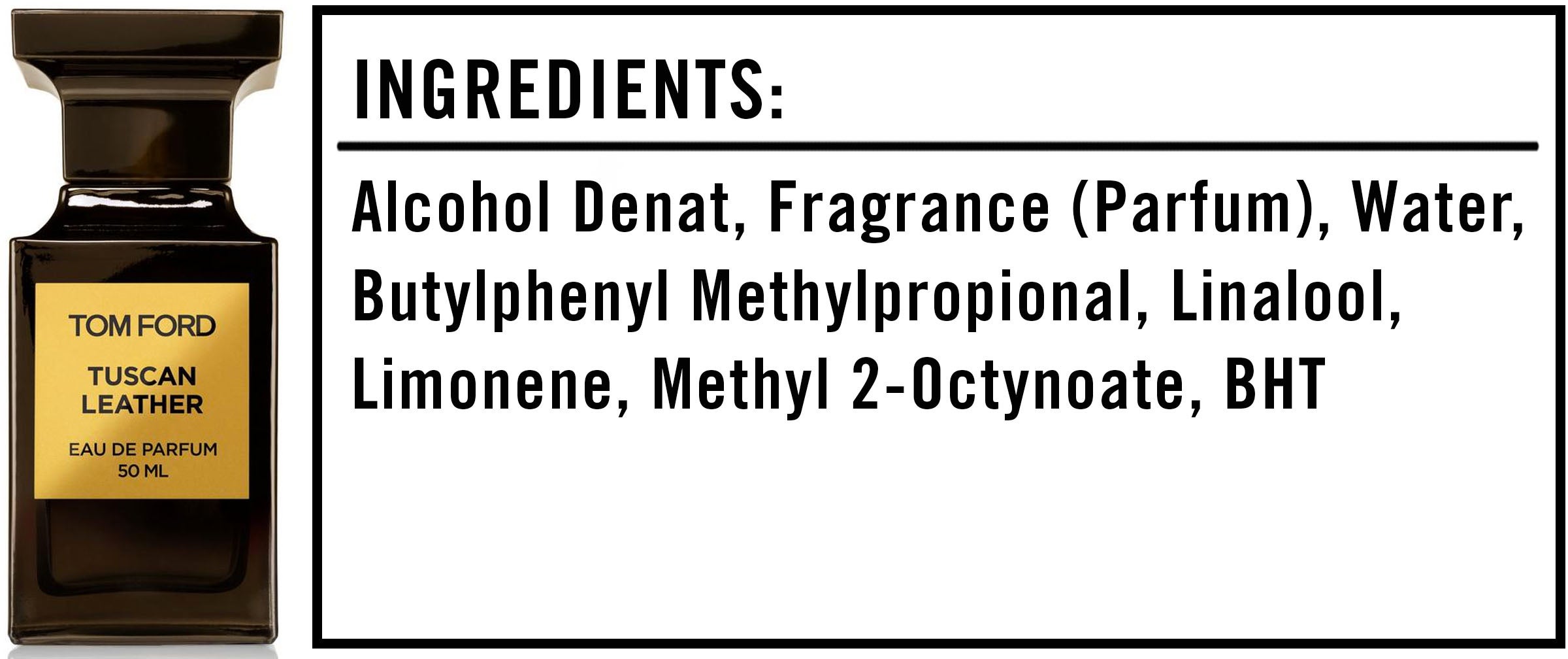We’re often told that you should never eat anything (or put anything on your body) if you don’t recognize everything on the ingredients list. But since most of us have no idea what xanthan gum or potassium benzoate are — or more importantly, what they’re doing to our bodies — we’re decoding the ingredients in the many things Americans put in (and on, or near) themselves.
This edition: Tom Ford Tuscan Leather Eau de Parfum, which is made from eight separate ingredients that we’ve broken down in the exact order they appear on their website.

The Ingredients
1) Alcohol Denat.: This is also known as denatured alcohol, or ethanol mixed with a second chemical — usually methanol or isopropyl alcohol — to make it unpalatable, something the government requires for inedible alcohol products to prevent people from making them into booze. “At high concentrations, denatured alcohol has been shown to irritate or dry out skin,” Dagan Xavier, ingredient expert and co-founder of Label Insight, explained during our analysis of the ingredients in spray sunscreen. “However, in most cosmetic products, alcohol is used at low concentrations (less than 5 percent) and can be an effective solvent or antimicrobial agent without having adverse effects on the skin.” In other words, this helps keep your cologne from going all stank.
2) Fragrance (Parfum): Unfortunately, fragrance recipes are considered to be proprietary information, so finding out exactly what produces the smell of this cologne is impossible (there are, however, a few fragrance ingredients listed below). That said, as Tom Ford’s website describes the scent, “This ultra-sexy interpretation captures the primal, animalistic scent of leather and its smooth voluptuous qualities.” Okay then!
One thing worth noting is that fragrances tend to be the leading cause of cosmetic contact dermatitis, i.e., a skin rash caused by contact with a certain substance. So if cologne makes your skin break out, this ingredient is the likely culprit.
3) Water, Aqua or Eau: This is a fancy cologne, so they just had to include the words for water in several different languages on the ingredients list. Either way, it acts as a base for the other ingredients.
4) Butylphenyl Methylpropional: A synthetic fragrance with a strong floral scent, butylphenyl methylpropional, also known as lilial, is highly limited in cosmetics, since even small amounts have been shown to result in allergic reactions, rashes, redness and oedemas (accumulations of fluid beneath the skin). Some animal studies also suggest that this ingredient has the potential to harm the male reproductive system. All in all, while the use of butylphenyl methylpropional is extremely restricted, it’s still an ingredient to keep away from whenever possible.
5) Linalool: This functions as a fragrance ingredient, producing a floral smell similar to lavender. Linalool is produced naturally by an assortment of plants, such as mint, cinnamon and birch trees, but it can also be formed synthetically.
6) Limonene: A chemical found in the peels of citrus fruits and other plants, limonene emits a sweet citrus odor and acts as a mild solvent, helping the various ingredients dissolve and mesh into one single cologne.
7) Methyl 2-Octynoate: Yet another synthetic fragrance ingredient, methyl 2-octynoate has been known to smell similar to a cucumber. Like many fragrance ingredients, it can cause contact dermatitis, but it’s also been deemed safe for use in cosmetics.
8) BHT: Also known as butylated hydroxytoluene, BHT is a synthetic antioxidant that works primarily as a preservative, slowing the deterioration of this product that might otherwise be caused by chemical reactions with oxygen. As one study notes, “It was concluded that BHT is safe as used in cosmetic formulations.” Nice!
The Takeaway
All fragrances have the potential to cause rashes and similar skin irritations, so blaming this scent specifically for that would be ludicrous. On the other hand, butylphenyl methylpropional is definitely a fragrance ingredient that has several well-known problems, even when used in small amounts, so we can blame them for using that. Still, should you be panicking if you spritz yourself with this cologne on occasion? Probably not. The horrible ingredients in your food could use that attention, instead.

